Living Christmas Calendar of Käpylä
| Living Christmas Calendar of Käpylä | ||||
|---|---|---|---|---|
| In the national inventory | ||||
|
Practitioners and people who know the tradition well
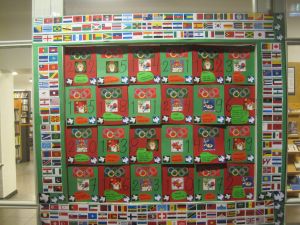
The Living Christmas Calendar of Käpylä interests everyone – without candies! – and motivates people to read, sing, play and get to know the area and its people. The event’s umbrella organisation is Käpylä-Seura ry (Käpylä Society). The event is open to all, and each year the organisations in the area are invited to participate in it with their own events in December. The only requirement is that the events included in the calendar, which are held around Käpylä, must be free of charge and open to all.
Every year, the event attracts both municipal and private parties, as well as organisations and inhabitants. Käpylä Library serves as a partner every year, and a large calendar with doors is hung up in the library’s entryway on 1 December. The calendar’s theme varies annually. Information on all the events in the calendar are also posted on the library’s wall (as well as in the Käpylä newspaper and on the Käpylä-Seura website and Facebook).
In 2019, for example, the participants included the aforementioned parties as well as Käpylän kirjastoyhdistys (Käpylä Library Association), the Scouts, the parish, Lions-Club, Käpyrinne ry, Käpylä Music Institute, ENTER ry, Ilves-teatteri (Ilves Theatre), Playground Kimmo of the City of Helsinki, Karjalan liitto ry (the Karelian Union), Käpylän Tiernapojat (Star Singers of Käpylä), Koskela Service Centre, the choir of Käpylä Comprehensive School, Druzhba – the Käpylä branch of the Finland-Russia Society, Kottby lågstadieskola (School of basic education in Swedish), Käpylän seudun ympäristöryhmä (Environmental Group of the Käpylä Region) and Käpyrinteen Vantterat ry. All inhabitants of Käpylä and visitors from elsewhere are welcome to participate in the lantern ceremony held in front of the library every evening at 6 pm and the opening of the next door of the calendar after the ceremony. Every year, the ceremonies have also been attended by passers-by who have happened to come there by coincidence or library users who have previously known nothing about the whole tradition. Some of them have come again on purpose afterwards, bringing with them children or friends or relatives who have connections to Käpylä or who have lived there at some point.
Practising of the tradition
The Living Christmas Calendar of Käpylä comprises the daily custom of lighting lanterns and opening a door of the calendar at 6 pm on the steps of Käpylä Library. Secondly, it comprises events open to all that are held all over Käpylä over the course of December. All events have free entry, and they are attended by dozens of inhabitants of various ages every day.
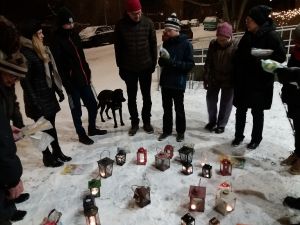
Every evening at 6 pm until Christmas Eve, the library’s steps are decorated with 24 lanterns and number of them are lit according to the date. The ceremony also includes the singing of Lyhtylaulu (‘Lantern Song’, traditional tune, lyrics by Tintti Karppinen). On the 1st of December, participants sing about one small candle with which all inhabitants are invited to participate: ‘Yksi pieni kynttilä nyt palaa näin / ja kalenteriviestiä vie eteenpäin, / ilta illan jälkeen tätä jatketaan / aattoon asti, tulkaa mukaan kaikki vaan!’ On the second day, the lyrics talk about two small candles: ‘Kaksi pientä kynttilää...’ and so on. To fit the lyrics with melody, there are some small changes with bigger numbers with more syllables. After the song has been sung, a nursery rhyme is used to decide who removes the calendar’s door and reads – with the help of an adult if needed – aloud the text written on the other side of the door. The reader also gets to keep the card. The text often includes a poem, Christmas Carrol, or other song, which is belted out together. It also always includes the following handwritten note: ‘Merry Christmas! From the Elves of Käpylä.’
The calendar base is mounted on a glass wall inside the library hall, while the doors are mounted on the entryway’s side of the wall to keep the base intact. It remains on display after Christmas Eve until ‘Evil Knut takes it away’ (a Finnish phrase) on Saint Knut's Day on 13 January. A theme is chosen every year, and the doors and the calendar base are related to this theme.
The theme for 2019 was the ABCs of Christmas. An exhibition of old ABC books, letter blocks and other toys related to the theme was compiled in a glass cabinet. The calendar base was a photo of the library that showed the 24 lanterns lit year after year in front of it. The photo also included a large Christmas tree decorated with ornaments = balls with letters. Two roosters (traditional mascots of Finnish ABC books) with elf hats on their heads were shown pointing their pointers at flip charts that featured images of Christmas trees. The calendar doors were marked with a letter or two (A-Ö) on the number side. For example, the letter I was written on door number six in honour of Finland’s Independence Day, door L was number 13 after Saint Lucy's Day, and door A was number 24 after the word ‘aatto’, which means eve. The nursery rhyme, game or song was written on the other side of the door, and the letters of that door were printed in bold and red. The first door revealed the letter K and the following nursery rhyme: ‘Kivaa on leikkiä kirjaimilla! / Koko laiva on lastattu K-alkuisilla, / koska ekaan luukkuun valitsimme Koon, / kun kokoonnumme Käpylän kirjastoon. / Käpylä-Seura näin Kalenterin avaa, / kaikki vuorollaan siitä aakkosia tavaa!’ (It is nice to play with letters...)
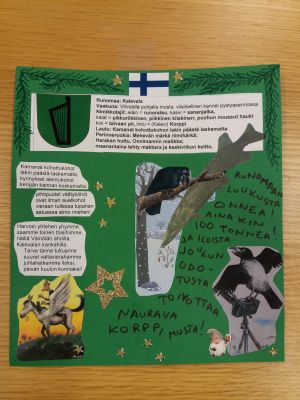
Door number five revealed the letters V and W and the following nursery rhyme: ‘Viidennen luukun voi arvata: / Veellä saa veneen nyt lastata. / V on myös numero roomalainen, / viksuthan hoksasi heti sen. / Wanhoja wiisuja veisataan / vuodesta toiseen, aina vaan. / Vaikka ei sanoja muistuisi mieleen, / väärätkin versiot tarttuu kieleen! / Värssyjä uusia keksiä saa ja / väännökset välillä naurattaa! / Vastausten pitää alkaa nyt veellä. / Valitse siis viisaasti, vaikka viiveellä / valtioita? eläimiä? kaupunkeja? kukkia? / Viiden joukkoon ei kuulu joulupukkia.’ (The fifth door is easy to guess, / with letter V we play without stress / it is also a Roman number...)
Every year, the programme includes the recycling came, which has been advertised as follows: ‘Christmas gifts available for the gifted and the ungifted! Bring a used toy, book, or something else and exchange it. You can also come without one – there are enough gifts for everyone!’ The game was invented by Tintti Karppinen for the Christmas calendar evenings of Käpylän seudun ympäristöryhmä. In the recycling game, gifts are placed on the ground or on the floor in a circle, inside transparent plastic bags, roughly 50 cm apart from each other. The players walk in a circle, hand in hand, while singing Kierrätysleikkilaulu (‘Recycling Game Song’, to the tune of trad. song Porsaita äidin oomme kaikki (‘Mom’s Little Piggies’). New lyrics by Tintti Karppinen: ‘Kierrätyslahjoja on tässä / pukinkonttiin pyrkimässä! / Tonttuja niitä etsimässä, ilomielin tässä! / Sinä ja minä, sinä ja minä!’ (Recycling gifts are waiting here you / and we elves are picking them, too... ... you and me, and me and you!)
When the lyrics get to the word ‘tässä’, everyone stops and sings the last line pointing with finger at the persons next to them and at themselves. Then everyone can take the gift in front of them if they want. The game continues until all the gifts have been picked or until no one no longer wants them. If there are not more gifts than players, everyone is only allowed to take one gift.
The background and history of the tradition
Jaana Hallamaa brought the idea over from Central Europe, and Tapanila- Seura (Tapanila Society) held an Advent event in 2007. They continue it as the Living Advent Calendar of Tapanila. Pirkko Alho from Käpylä read a story about this calendar in 2009, which led to the establishment of a working group to implement Käpylä’s own and original Living Christmas Calendar. Since 2010, Käpylä-Seura took responsibility of the calendar. Many local parties and inhabitants participate in the tradition. The programme is put together in autumn, and everyone can sign up for it, if their event is open to all and free of charge. The programme is published at the library, in the Käpylä newspaper and on the Käpylä-Seura website and Facebook. In the early years, lanterns were taken out to events of each organiser, held around Käpylä, but they have been concentrated at the library since 2012.
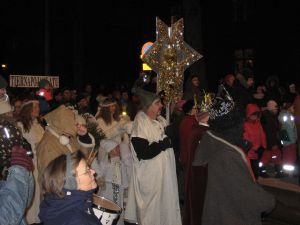
The themes of the calendar itself vary. In 2014, the calendar explored the history of different places. The calendar base was an enlargement of the map used in the Käpylä game. The calendar doors featured a photograph and information about the people and buildings of the depicted place as well as other things of note. The number six was on top of Taivaskallio, which always hosts an Independence Day flag-raising ceremony at 9 am. The door for Untamontie 7 featured a story and a photo of children in the yard from 1945. The “better dressed” children stood behind - they had just returned to Finland from Sweden where they were sent to be safe during the war. Thanks to Marjut Jousi, the calendar included also funny stories about the residents of the houses on Kotipolku and about neighbourhood assistance.
2015 was declared by the Finnish Reading Center as the Year of the Book, and it also marked the 90th anniversary of tram 1, which is loved by the inhabitants of Käpylä. The calendar base was a photo of the tram. Christmas Carrols were written on the windows and elves as passengers. On the 24th, Father Christmas was revealed as the driver, and all the Christmas songs on the windows were sung during the door’s opening ceremony. The doors featured book covers on the front and a poem or text on the back. The very first door succeeded in realising the idea about inspiring children to read - after hearing the poem, one little girl said: ‘Daddy, let’s go borrow that book!’
The Summer Olympics were held in Rio de Janeiro in 2016, and the calendar’s theme for the year was clear: Olympic games. We have in Käpylä two Olympic villages, built in 1940 when games were cancelled by war, and 1952, when Helsinki was the host. After all, Käpylä had once housed the legendary cinema Rio. Its premises currently house Ilves-theatre, which also participates in the calendars. By combining the Soviet Union and Russia, as well as both Koreas, all the host countries of the games fit behind 24 doors! Number 21 featured poems by Aale Tynni, who won gold at the Art Competition held as part of the 1948 Summer Olympics in London. Among those mentioned behind the Helsinki door, number 24, was Yrjö Lindegren, the designer of the Serpentine House in Käpylä. It received alter an award for the renovations carried out in 2019. Lindegren designed the Helsinki Olympic Stadium together with Toivo Jäntti and won gold in the town planning category of the Art Competition of the Summer Olympics in London.
The theme of 2017 was, of course, Finland 100, the centenary of Finland’s independence. The library’s glass cabinet displayed 100 handmade, blue-and-white elves that congratulated Finland together with elaborate and humorous stone sculptures made by Olavi Heikkilä (age 87), a former inhabitant of Käpylä. All the elves were sold after Christmas at a voluntary price, and the profits were donated through UNICEF to help children suffering from the Syrian Civil War. The calendar base comprised an enlarged map from a famous Finnish Children’s book ‘This is Finland’ as well as elves, provincial animals and plants. The doors featured Finnish regions, and, as they only numbered 19, an old one (Itä-Uusimaa) and four new, fantasy ones were also included: Runomaa (Poetry Land), Satumaa (Fairy Land), Laulumaa (Song Land) and Joulumaa (Christmas Land). Behind every door, even the made-up ones, were the lyrics to the regional song; the region’s capital and coat of arms; the region’s signature animals, plant and stone; as well as traditional foods. For example, the capital of Runomaa was Kalevala, its coat of arms was a five-string kantele (a national Finnish string instrument), its signature animal was a horse (Pegasos), its signature plant was bracken (a language joke as the Finnish name ‘sananjalka’ translated word-by-word is ‘foot of a word’) and its traditional foods included succulently moist salted beef (a language joke, too, word-by word translation would be ‘beef of a rhyme’) and some other food with jokes of names. In Finnish, all these things are references to well - known poetry. The regional song was, of course, Satumaa - (Fairy Land), the most famous Finnish tango with the same name, lyrics, and melody by Unto Mononen. Pictures related to the information had been glued to every door. Almost all the regional songs were familiar – though the song Oolannin sota (War of Åland) was added to the door for the Åland Islands, just in case. The song was belted out with gusto, and the young participants found it very amusing.
The theme of 2018 was Elves of All Kinds. Photos of Käpylä residents in different situations – at evening gatherings at the library, on board tram 1 in celebration of its birthday and at calendar events – were glued to the cardboard base. Elf hats were photoshopped on everyone’s heads, and no one was asked for their permission to have their photo put in the calendar. Every evening, when a new door was opened, it was said in jest: ‘we’ll see you in court’ if anyone wanted to file a lawsuit for unauthorised publication of their photo. No lawsuits have been filed.
The transmission of the tradition
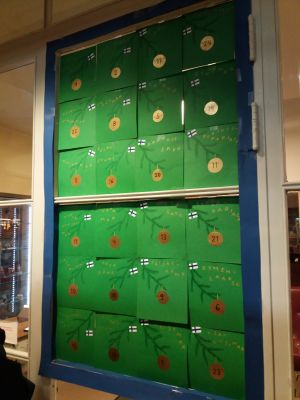
The events included in the calendar programme have become an important part of each organiser’s activities. Year after year, the boards of associations and societies, as well as their old and new members, write the event down in their action plan and sign up for it. In the early autumn, Käpylä-Seura sends out an invitation to ask what each party intends to organise and where and when and to update . It asks, too, each party to update their contact details as well as to invite other interested parties to join. All are welcome and can have their event added to the joint programme.
Calendars as such are an old and familiar idea both in Finland and elsewhere in the world, but they are mostly known as the version that people put on their wall. Many organisations, such as the Scouts and the Finnish Red Cross, produce their own calendars every year and sell them to obtain funds for their activities. Today, the doors of commercial Christmas calendars often also hide chocolate or other candy.
Tintti Karppinen has talked about the idea of the tradition of the Living Christmas Calendar of Käpylä when holding lectures or workshops about ‘Drama, Games and Cooperation’ at congresses and seminars in the field of drama and theatre around the world. The calendar has served as an example of community spirit and a playful tradition that brings different generations together. One important characteristic is that the events are open to all, free of charge. The idea is easy to apply anywhere in the world, as it works in all languages and is not tied to any religion or geographic area.
At a seminar called Community-powered Urban Commons, held in Warsaw in 2016, Puu-Käpylä was presented as an example of the saving of old buildings and the preservation of an area’s vitality. The Living Christmas Calendar of Käpylä was included in the presentation as an example of the community spirit in the area and the continuity of cultural heritage.
A PowerPoint presentation in English was also made about the Olympics-themed calendar of 2016, when a seminar titled ‘Arts and Inter-Generational Work’ was held at Teatro Chapitô, in Lisbon on 7 July 2017 about art events that connect different generations. The Living Christmas Calendar of Käpylä was featured there as one of the examples.
Käpylä celebrates its 100-year history as a residential area in 2020, as the Helsinki City Council signed the agreement on the building of the area on 6 April 1920. This year, the Living Christmas Calendar of Käpylä will be implemented on a larger scale than usual. School classes will also be invited to participate in the event from the planning phase onwards, and ideas will be implemented together with them. The anniversary year will also be considered already over the course of January–November by the events of all organising parties and in the wall calendar itself. The calendar will focus on the area’s (cultural) history over the last hundred years and, particularly, the passing on of traditions from generation to generation and to future residents. At the December events, different age groups will share their experiences and traditions related to Christmas with each other – including games, songs, stories, food, and decorations, among other things.
The future of the tradition
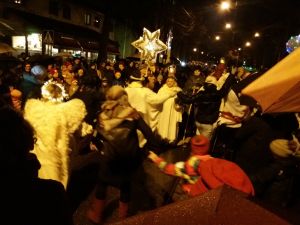
The future of the Living Christmas Calendar of Käpylä tradition is guaranteed, surely, as the programme has included participants of various ages and numerous event organisers every year. Furthermore, people continue to want to celebrate Christmas in so many ways that there is reason to assume that the varied events will retain their attractiveness. In addition to enjoying pastimes offered by technology, people of all ages have clearly had a need to come together in person to sing, play, tell stories, cook food, craft and learn new Christmas or other customs.
It has been wonderful to note that the idea has garnered interest from teachers and educators - and not only in Finland. The idea is easy to apply to the traditional celebrations of each country, as it does not have to be tied to the Christian Christmas. That is why the name does not include the word Advent. It is possible to make a calendar that is e.g. five to 31 days long for the period preceding any celebration to both emphasise the value of the celebration or event and to turn the wait for it into its own, playful series of events.
Everyone is welcome to participate in the Living Christmas Calendar of Käpylä, regardless of age, cultural background, language, political or religious views or other characteristics. It is difficult to imagine a future in which people no longer want to gather together to enjoy pleasant events that cost nothing, or in which such a large group of organisers would stop implementing their popular December events that have already become a tradition.
Käpylä-Seura is strongly committed to continuing to play the role of the Living Christmas Calendar’s umbrella organisation, i.e. to gather different local parties and operators together every year to participate as organisers in this diverse traditional event, which has a programme that also interests people living elsewhere. Particularly the numerous concerts and the Star Singers’ procession, which fills the whole Pohjolankatu, always attract hundreds of participants.
The community/communities behind this submission
Koskela Service Centre and cultural activities
Käpylän Venäjä -seura Druzhba ry
Playground Kimmo of the City of Helsinki
Käpylän seudun ympäristöryhmä
KÄPYNET
Bibliography and links to external sources of information
Käpylä-magazines 9/2019, 10/2019 and issues of November and December 2009-2018
